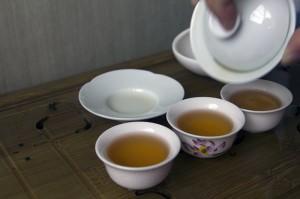By far one of the most common questions asked by customers is this:
“Which tea is the healthiest?”
Right off the bat, there is no simple answer to this question.
Many would expect a simple answer like “green tea” or if you prefer a little more specificity “Xihu Longjing” for example.
Certainly as a vendor it would be tempting: “xxx tea, it has the most antioxidants. Can I get you a packet?”
That simplifies the decision process which many marketers point to as the most effective strategy.
That is also dishonest if you eliminate the euphemism.
That’s why we are taking 3-4 articles to answer this simple question.
What’s in my tea?
To answer which tea is the healthiest, we can start by looking at the different chemical compounds in tea and their associated health benefits.
At the present moment, there are more than 500 identified substances in tea. We will look at just 3 of the most important groups and some of the research conducted on them.
1) Tea Polyphenols
This is one of the most important chemical compounds in tea, constituting about 20-35% of the dry leaves content.
Of which the most important category is known as flavanols which constitutes approximately 60-80%[1] of all tea polyphenols.

i) epigallocatechin-3-gallate (EGCG)
ii) epicatechin (EC)
iii) epicatechin-3-gallate (ECG)
iv) epigallocatechin (EGC)
v) Catechins
EGCG in particular has been the subject of much research. Below are just 3 with extracts from the linked:
a) Cardiovascular and metabolic health[2]
“Dose-response relationships observed in several epidemiological studies have indicated that pronounced cardiovascular and metabolic health benefits can be obtained by regular consumption of 5-6 or more cups of green tea per day. Furthermore, intervention studies using similar amounts of green tea, containing 200-300 mg of EGCG, have demonstrated its usefulness for maintaining cardiovascular and metabolic health”
b) Protection against Parkinson’s disease[3]
“Experimenting on fruit flies carrying mutated genes known to be involved in Parkinson’s disease, those specimens treated with EGCG were able to move better and preserve a substantial amount of their brain neurons. The investigation determined that the compound activated the protein AMP kinase, preventing brain cells from dying under conditions of stress.”
c) Reduction of risk in cancer (cited study on digestive system cancers[4])
“….women who consumed ≥150 g tea/mo (∼2–3 cups/d) had a 21% reduced risk of digestive system cancers combined (HR: 0.79; 95% CI: 0.63, 0.99). The inverse association was found primarily for colorectal and stomach/esophageal cancers.”
2) Amino Acids
Amino acids constitute about 2-5% of tea leaves content but they are one of the most important components.
Amino acid, specifically l-theanine has been the subject of research ever since its discovery in 1949. This is by no means exhaustive but here are some researches:
a) Relaxation and reduction in blood pressure [5]

b) Anti-depressant like effects[6]
“L-theanine produced an antidepressant-like effect, since the administration of L-theanine at doses of 1, 4 and 20 mg/kg for 10 successive days significantly reduced the immobility time in both the forced swim test and tail suspension test, compared with the control group, without accompanying changes in ambulation in the open-field test.”
c) Impact on body weight control and fat accumulation[7]
“These results indicated that bodyweight increase and fat accumulation were suppressed by a limited concentration of 0.04% theanine in mice.”
3) Carbohydrate compounds
Carbohydrate compounds constitute approximately 20-25% of the dry leaves and are partially responsible for the sweetness in tea.
Of the multiple types of carbohydrate compounds, tea polysaccharides has been the subject of most health related research.
a) Antioxidative effect of Oolong tea Polysaccharides on Streptozotocin induced diabetic rats
“{Oolong tea polysaccharides} significantly reduced blood glucose (BG), nitric oxide (NO) and malondialdehyde (MDA) concentration and activity of nitric oxide synthase (NOS) in serum of diabetic rats, meanwhile the activities of superoxide dismutase(SOD), glutathione peroxidase (GSH-PX), and the content of insulin in serum were increased.”
b) Impact of tea polysaccharides on lowering blood pressure[8]
22.5mg/ml of tea polysaccharides were administered to SD rates and after 30 minutes, blood pressure lowered by 28 mmHg and heartbeat fell by 15%
4) Others
Other compounds include alkanoids, proteins, vitamins and more which we will not be able to discuss in this article.
Conclusion or is there one?
Does it then stand to reason that if we seek out the type of tea with the highest content of a particular compound, we can then use it to achieve a particular set of health related goals?
Here we can give a simple answer- no.
And the “no” occurs on several fronts, which we will discuss in the next few articles.
Next up, we will look at how tea is being classified and which type of tea could potentially have the highest of a particular chemical compound as well as how that still doesn’t answer the question of “which tea is the healthiest”.
See here for other frequently asked tea related questions
See here for more articles related to tea and health
[1] Page 12 of 茶医学研究 published by浙江大学出版社edited by 朱永兴,王岳飞 et al
[2] http://www.ncbi.nlm.nih.gov/pubmed/17906191
[3] http://newshub.nus.edu.sg/headlines/1301/tea_03Jan13.php
[4] http://ajcn.nutrition.org/content/96/5/1056.abstract
[5] http://www.jphysiolanthropol.com/content/31/1/28
[6] Antidepressant-like Effects of L-theanine in the Forced Swim and Tail Suspension Tests in Mice
[7] Effect of theanine, γ-glutamylethylamide, on bodyweight and fat accumulation in mice
[8] 王丁刚,王淑如。茶叶多糖血管系统的部分药理作用,1991
